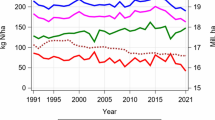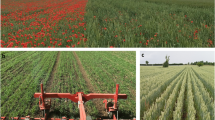Abstract
An increasing interest in sustainable forms of agriculture exists worldwide and the demand for varieties specifically adapted to organic and low-input agriculture is rising. As a consequence, breeding methods need to be refined accordingly. In order to get better insight into needs and possibilities with this regard, a comprehensive ring test was performed from 2006 to 2008 with 14 winter wheat varieties in 36 environments in major cropping regions of Austria, France, Romania and Switzerland. Environments were grouped into 9 different subsets according to input systems, years, and countries. Input system N0 consisted of 13 organic and 6 no-input trials; 17 trials in input system N received various levels of synthetic nitrogen. For grain yield (YLD) and protein yield (PYLD), significant G × E was detected. Countries had a stronger effect on both traits than systems. Overall, it was more efficient to select YLD and PYLD in N, for targeting both systems N and N0. For PYLD, direct testing within a given country was always more efficient than indirect selection. Many traits could be scored equally well in both systems, N and N0, but for some traits particularly important for organic agriculture, such as soil coverage, better differentiation was observed under organic conditions. Therefore, we agree with other authors that a commercially sustainable breeding program for organic and low-input agriculture should combine information from high and low-input levels and from diverse regions. Local testing of varieties, however, remains indispensable.


Similar content being viewed by others
Abbreviations
- H:
-
Broad sense heritability
- LI:
-
Low-input (conventional) trials
- N0:
-
Without synthetic nitrogen supply
- N:
-
With synthetic nitrogen supply
- NI:
-
No-input (conventional) trials
- OA:
-
Organic trials
- PROT:
-
Protein content
- PYLD:
-
Protein yield
- RE:
-
Relative efficiency of indirect selection
- YLD:
-
Grain yield
References
AGES (2013) Österreichische beschreibende Sortenliste. http://www.baes.gv.at/pflanzensorten/oesterreichische-beschreibende-sortenliste/pdf-version-der-bsl-2013. Accessed 20 Nov 2013
Baenziger PS, Salah I, Little RS, Santra DK, Regassa T, Wang MY (2011) Structuring an efficient organic wheat breeding program. Sustainability 3:1190–1205. doi:10.3390/su3081190
Bernal EF, Villardon PG (2013) Package ‘GGEBiplotGUI’. http://www.inside-r.org/packages/cran/GGEBiplotGUI/docs/GGEBiplotGUI. Accessed 5 Dec 2013
BLW (2013) Direct payments. http://www.blw.admin.ch/themen/00006/index.html?lang=en. Accessed 5 Dec 2013
Brancourt-Hulmel M, Heumez E, Pluchard P, Beghin D, Depatureaux C, Giraud A, Le Gouis J (2005) Indirect versus direct selection of winter wheat for low-input or high-input levels. Crop Sci 45:1427. doi:10.2135/cropsci2003.0343
Cormier F, Faure S, Dubreuil P, Heumez E, Beauchêne K, Lafarge S, Praud S, Le Gouis J (2013) A multi-environmental study of recent breeding progress on nitrogen use efficiency in wheat (Triticum aestivum L.). Theor Appl Genet 126(12):3035–3048. doi:10.1007/s00122-013-2191-9
Falconer DS, Mackay TFC (1997) Introduction to quantitative genetics, 4th edn. Longman, Harlow
Gauch HG, Piepho H-P, Annicchiarico P (2008) Statistical analysis of yield trials by AMMI and GGE: further considerations. Crop Sci 48:866. doi:10.2135/cropsci2007.09.0513
Hildermann I, Messmer M, Kunz P, Pregitzer A, Boller T, Wiemken A (2010) Sortex Umwelt-Interaktionen von Winterweizen im biologischen Landbau. In: Österreichs VdPuS (ed) Tagungsband der 60. Jahrestagung der Vereinigung der Pflanzenzüchter und Saatgutkaufleute Österreichs, pp 163–165
Kamran A, Kubota H, Yang R-C, Randhawa HS, Spaner D (2013) Relative performance of Canadian spring wheat cultivars under organic and conventional field conditions. Euphytica 196:13–24. doi:10.1007/s10681-013-1010-3
Kebede AZ, Mahuku G, Burgueño J, Vicente FS, Cairns JE, Das B, Makumbi D, Magorokosho C, Windhausen VS, Melchinger AE, Atlin GN (2013) Effectiveness of selection at CIMMYT’s main maize breeding sites in Mexico for performance at sites in Africa and vice versa. Plant Breed 132:299–304. doi:10.1111/pbr.12063
Kirk AP, Fox SL, Entz MH (2012) Comparison of organic and conventional selection environments for spring wheat. Plant Breed 131:687–694. doi:10.1111/j.1439-0523.2012.02006.x
Lammerts van Bueren ET, Myers JR (2012) Organic crop breeding. In: Myers JR, Lammerts van Bueren ET (eds) Organic crop breeding. Wiley, Hoboken, pp 3–12
Lammerts van Bueren ET, Østergård H, Goldringer I, Scholten O (2008) Plant breeding for organic and sustainable, low-input agriculture: dealing with genotype–environment interactions. Euphytica 163:321–322. doi:10.1007/s10681-008-9731-4
Lammerts van Bueren ET, Jones SS, Tamm L, Murphy KM, Myers JR, Leifert C, Messmer MM (2011) The need to breed crop varieties suitable for organic farming, using wheat, tomato and broccoli as examples: a review. NJAS Wageningen J Life Sci 58(3–4):193–205. doi:10.1016/j.njas.2010.04.001
Löschenberger F (2009) Winterweizen für den Biolandbau: Vergleich der Effizienz von Selektionsparametern: inwieweit können konventionelle Versuche für die Bio-Selektion in frühen Generationen herangezogen werden. In: Hartl W, Schweiger P, Hofer M, Diethart I (eds) Österreichisches Saatugt-/Sortenprojekt für den Biolandbau 2004–2009. Bio Forschung Austria, Vienna, pp 172–219
Löschenberger F, Fleck A, Grausgruber H, Hetzendorfer H, Hof G, Lafferty J, Marn M, Neumayer A, Pfaffinger G, Birschitzky J (2008) Breeding for organic agriculture: the example of winter wheat in Austria. Euphytica 163:469–480. doi:10.1007/s10681-008-9709-2
Mason HE, Spaner D (2006) Competitive ability of wheat in conventional and organic management systems: a review of the literature. Can J Plant Sci 86(2):333–343. doi:10.4141/P05-051
Murphy KM, Campbell KG, Lyon SR, Jones SS (2007) Evidence of varietal adaptation to organic farming systems. Field Crop Res 102:172–177. doi:10.1016/j.fcr.2007.03.011
Oberforster M, Werteker M (2009) Relative Vorzüglichkeit verschiedener Weizensorten in Abhängigkeit von Ertrag, Qualität und Erzeugerpreisen. In: Mayer J, Alföldi T, Leiber F et al. (eds) 10. Wissenschaftstagung zum Ökologischen Landbau, Zürich, 11–13th February 2009, pp 302-305
Przystalski M, Osman A, Thiemt EM, Rolland B, Ericson L, Østergård H, Levy L, Wolfe M, Büchse A, Piepho H-P, Krajewski P (2008) Comparing the performance of cereal varieties in organic and non-organic cropping systems in different European countries. Euphytica 163:417–433. doi:10.1007/s10681-008-9715-4
RDC Team (2014) R: A language and environment for statistical computing. Austria, Vienna
Reid T, Yang R-C, Salmon DF, Spaner D (2009) Should spring wheat breeding for organically managed systems be conducted on organically managed land? Euphytica 169:239–252. doi:10.1007/s10681-009-9949-9
Reid T, Yang R-C, Salmon DF, Navabi A, Spaner D (2011) Realized gains from selection for spring wheat grain yield are different in conventional and organically managed systems. Euphytica 177:253–266. doi:10.1007/s10681-010-0257-1
Rolland B, Le Campion A, Oury FX (2012) Pourquoi sélectionner de nouvelles variétés de blé tendre adaptées à l’agriculture biologique? Courrier de l’environnement de l’INRA 62:71–85
Stagnari F, Onofri A, Codianni P, Pisante M (2013) Durum wheat varieties in N-deficient environments and organic farming: a comparison of yield, quality and stability performances. Plant Breed 132:266–275. doi:10.1111/pbr.12044
Weber VS, Melchinger AE, Magorokosho C, Makumbi D, Bänziger M, Atlin GN (2012) Efficiency of managed-stress screening of elite maize hybrids under drought and low nitrogen for yield under rainfed conditions in Southern Africa. Crop Sci 52:1011. doi:10.2135/cropsci2011.09.0486
Willer H, Kilcher L (eds) (2013) The world of organic agriculture. Statistics and emerging trends. IFOAM, Bonn
Wortman SE, Ca Francis, Galusha TD, Hoagland C, Van Wart J, Baenziger PS, Hoegemeyer T, Johnson M (2013) Evaluating cultivars for organic farming: maize, soybean, and wheat genotype by system interactions in Eastern Nebraska. Agroecol Sustain Food Syst 37:915–932. doi:10.1080/21683565.2013.764956
Yan W, Holland JB (2009) A heritability-adjusted GGE biplot for test environment evaluation. Euphytica 171:355–369. doi:10.1007/s10681-009-0030-5
Yan W, Kang MS, Ma B, Woods S, Cornelius PL (2007) GGE biplot vs. AMMI analysis of genotype-by-environment data. Crop Sci 47:643. doi:10.2135/cropsci2006.06.0374
Yang R-C, Crossa J, Cornelius PL, Burgueño J (2009) Biplot analysis of genotype × environment interaction: proceed with caution. Crop Sci 49:1564. doi:10.2135/cropsci2008.11.0665
Acknowledgments
We thank Heinrich Grausgruber for statistical advice, we are grateful to Hannah Keely Smith for English writing advice and to Matt Clark (PotentProofreading.wordpress.com) for English proof reading. This work was initiated in the framework of the EU supported cost action 860 SUSVAR (http://www.cost860.dk) and data analysis was supported by EU FP7– project SOLIBAM (http://www.solibam.eu).
Author information
Authors and Affiliations
Corresponding author
Rights and permissions
About this article
Cite this article
Muellner, A.E., Mascher, F., Schneider, D. et al. Refining breeding methods for organic and low-input agriculture: analysis of an international winter wheat ring test. Euphytica 199, 81–95 (2014). https://doi.org/10.1007/s10681-014-1169-2
Received:
Accepted:
Published:
Issue Date:
DOI: https://doi.org/10.1007/s10681-014-1169-2




